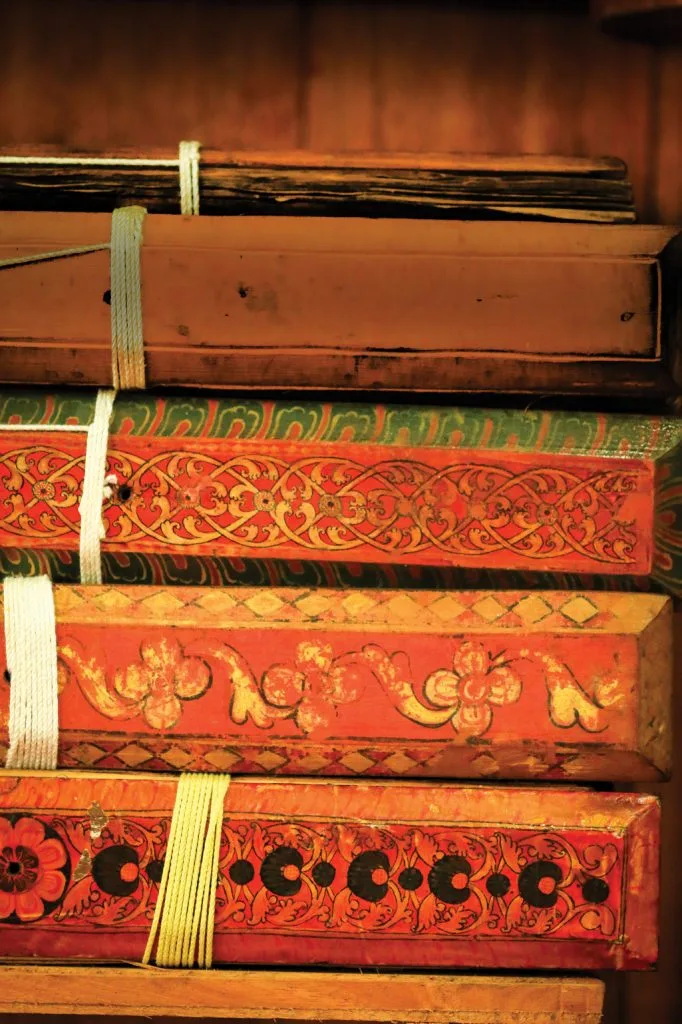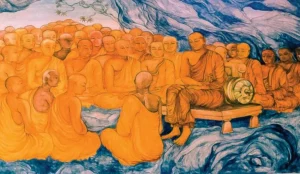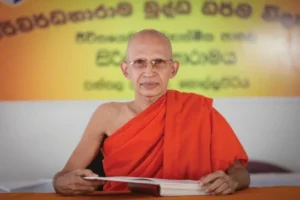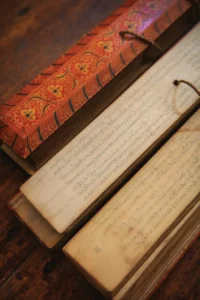
Nikini Pōya, according to the calendar, August is also very important for all Buddhists all over the world, as the day of laying the foundation stone to restore the Dhamma or the doctrine preached by the Lord Buddha, about six centuries BCE. The first Buddhist council was gathered by senior monks of the Buddhist Order convened three months after the Gautama Buddha’s demise 483 BCE.

This first convocation was held at Rajagaha (modern Rajgir, Bihar in India). It was presided over by Mahakasyapa Thera, one of the most senior disciples an Arhat at the Sapta Panni cave near Rajagaha with the patronage of King Ajathasatta on Nikini Full Moon Poya Day, with the participation of 500 Arhants enlightened senior monks. Thus, it is called Panca satika sangeti or the council of five hundred arahants. And it states that the First Council lasted for seven months.
First, it should be known what the Buddhist Council is: what it really means. The word council is termed as ‘Sangayana’ in the sense of ‘reciting together’. It is also known as ‘sangiti’ in Pali, a convocation of the Buddhist monk to settle doctrine. According to the council, they wanted to make unique teaching of The Buddha after His Parinibbana, demise. That means its objective was to preserve the Buddha’s sayings (suttas) and the monastic discipline or (Vinaya) rules. Even though the Buddha allowed the monks to abolish the minor rules, they made the unanimous decision to keep all the rules of the Vinaya unchanged.
At this council, Venerable Ananda Thera recited the Suttas, such that each begins: ‘Evam mesutam’ means, ‘Thus I have heard’ and the monk Venerable Upali Thera recited the Vinaya or monastic discipline rules. Therefore, in this council, the doctrine was divided into two chapters: Sutta and Vinaya. The Vinaya was consist with five books as Parajika Pali, Pacittiya Pali, Mahawagga Pali, Chullawagga Pali and Pariwara Pali, (Pali-norm). This is mentioned at that time as the ‘Vinaya Code’.
At this convocation, The Dhamma or all discourses preached by the Buddha was discussed and divided, into five books namely, Nikayas or groups as; firstly, long discourses are named as Digha Nikaya, secondly medium discourses as Majjhima Nikaya, thirdly some short discourses as Sanyutta Nikaya, fourthly very short discourses as Anguttara Nikaya, and fifthly few collections as Khuddaka Nikaya. Furthermore, it is mentioned in Mahavagga Pali that all discourses by The Buddha were included in this section; thus, it is called ‘Dhamma or Doctrine’. Therefore, in this period, there was only Dhamma and Vinaya, according to the Mahavagga Pali. And it will be understood clearly by this chart;
The five Nikayas (collections) comprises the Sutta Pitaka:
– Digha Nikaya – a collection of long discourses – 34 discourses
– Majjhima Nikaya – a collection of middle discourses – 152 discourses
-Sanyutta Nikaya – a collection of related discourses – 7,762 discourses
-Anguttara Nikaya – collection of numerical discourses – 9,557 discourses
-Khuddaka Nikaya – a minor collection
There are just 17,505 discourses merely in the first four Nikayas, except Khuddaka Nikaya. In Khuddaka Nikaya also there are 15 discourses preached by The Lord Buddha. Furthermore, this text has mentioned the Abhidhamma Pitaka as well. It mentions the Abhidhamma was included in Dhamma. Hence, it is said ‘Dhammena hettha dwe pitakani vuttani’ – means by The Dhamma, it is mentioned as two sections. That is Sutta (Doctrine) and Abhidhamma. Therefore, until the third council, in 300 BCE, there was Dhamma and Vinaya or Doctrine and Discipline code. Thus, the word ‘Tipitaka’ is not mentioned in Buddhism yet. ‘Pitaka’ (Here Pitaka means; is a later collective appellation of the Scriptures; the first division of the canon being into Sutta and Vinaya – Pali-English Dictionary by T.W.Rhys Davids). Besides this first council, there were another four councils in the Theravada School. The third council was very important to mention here, adding The Abhidhamma to the mainstream. Hence, all these discourses are named Sutta Pitaka, Vinaya Pitaka, Abhidhamma Pitaka, The Tipitaka, or Tepitaka – three canon. On the other hand, there was another division in the Sasana or Buddhism earlier, when The Buddha was alive. It is called; Nawanga Satthu Sasana or nine divisions of Buddhism, namely
1. Sutta – discourse.
2. Geyya – preachings.
3. Veyya Karana – comments.
4. Gata – stanzas.
5. Udana – quotes.
6. Ithi Vuttaka – preaching doctrine.
7. Jataka – birth stories of Bodhi Satwa
(The Buddha’s stories in previous
lives).
8. Adbhuta Dhamma – mysteries.
9. Wedalla – obscure
Why was this convocation held at this moment, within just three months of Lord Buddha’s demise? The first reason for this meeting was monk Subhadra, who wanted to relax Vinaya’s rules. Meanwhile, some undesirable monks, too, joined the Buddhist Order for worldly gains, like today. This Subhadra was also that kind of monk who joined the Order in his old age. This Bhikku Subhadra requested mourners not to weep when the Lord Buddha was demised but be happy and rejoice because they are now free to do anything they want as the Master is not there.

Further, this Bhikku Subhadra stated that the Buddha had been an obstacle to their freedom. And secondly, it was clear that different interpretations and various assumptions on the original doctrine arose during that period. Therefore, the learned senior monks wanted to recite and protect the Buddha wachana or Lord Buddha’s words and keep them collected.
But this first council was not completely accepted by all monks. Venerable Purana and his 500 disciples arrived at Rajagaha and were met by elderly monks who asked him to submit and learn the texts. However, Venerable Purana would only bear in mind what he had heard in the Lord’s presence, directly from Him. That is why the Buddha has said to Ananada as this in Maha Parinibbhana sutta, (The Buddha’s last discourse) if it occurs to any of you, “The teaching has lost its arbitrator; we are without a teacher” do not view it in that way. Whatever Dhamma and Vinaya I have pointed out and formulated for you, that will be your teacher when the Lord Buddha demise.
Another significance is the connection with Nikini Poya is ‘Vas observation’ – the rainy season retreat. Vas can be divided into two segments. Pera Vas – pre rainy season retreat and Pasu Vas – post rainy season retreat. However, the monks who fail to observe pre-Vas retreat on the Esala Poya (June) can observe post-Vas retreat on Nikini Poya Day. This late commencement of Vas or rainy retreat sojourn is called ‘Pasu Vas, in Pali’.

So that who observe vas retreat on the Esala Poya day, they complete one month up to Nikini PoyaJuly. On the other hand, among all these 17,505 Sutras, mostly, I appreciate only a few. Among them are ‘Satara Satipatthana sutta – for meditation, Kesaputtiya Kalama Sutta – to know how to accept real things, Aggann a Sutta – describe how human beings are created on earth, Vitakka Santhan Sutta – teaches how to control the thoughts, Alagaddupam sutta – show the real way to accept Dhamma and Ratana sutta – for protection and meditation. The question is not about the monks or the Buddha or who has written the Tipitaka-Scripture, but how far one develops his own soul (Atma) by using this unique doctrine.
Information provided by:
Ven Diyapattugama Revatha Thero
(B.A., M.A., M.Phil.)
Expert Psychological Counselor and
Meditation Teacher
Siriwardhanarama Buddha Dhamma
College
Manodaya Meditation Center
Siriwardhanaramaya, Temple Lane,
Kollupitiya
sirirevathad@gmail.com
dhammavedi.com
exploresrilanka.lk AUGUST 2021 | EXPLORE SRI LANKA


